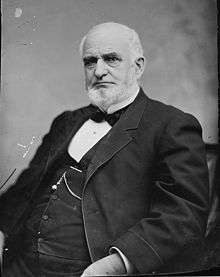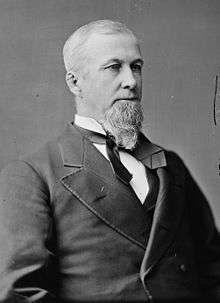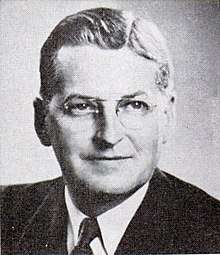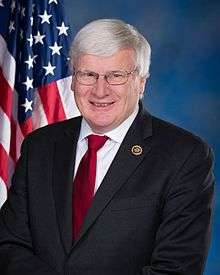Wisconsin's 6th congressional district
Wisconsin's 6th congressional district is a congressional district of the United States House of Representatives in eastern Wisconsin. It is based in the rural, suburban and exurban communities between Madison, Milwaukee, and Green Bay. It also includes a small portion of far northern Milwaukee County around River Hills. The district is currently represented by Glenn Grothman (R-Campbellsport) who took office in January 2015.
| Wisconsin's 6th congressional district | |||
|---|---|---|---|
.tif.png) Wisconsin's 6th congressional district - since January 3, 2013. | |||
| Representative |
| ||
| Area | 5,641.16 sq mi (14,610.5 km2) | ||
| Distribution |
| ||
| Population (2018 est.) | 714,886 | ||
| Median income | $59,868[1] | ||
| Ethnicity | |||
| Cook PVI | R+8[3] | ||
The 6th district has a long history of farming livestock in rural areas,[4] and is a major producer of both milk and grains.[5]
In the 2016 presidential election, the district voted 55% for Donald Trump and 38% for Hillary Clinton.[6]
History
Wisconsin's 6th congressional district came into existence in 1863 following the federal census of 1860. The first elected representative from the district was Walter D. McIndoe of Wausau. The district originally comprised the counties of the northern and western parts of the state. Following subsequent congressional reapportionment after each decennial census, the district's boundaries shifted eastward.
Census of 1860

The reapportionment of Congressional districts following the federal census of 1860 gave Wisconsin three additional members in the House of Representatives. Members elected from the newly created 4th, 5th and 6th districts were chosen in the midterm elections of 1862 and took their seats in the lower house as part of the 38th United States Congress.
The 6th District originally included the counties of Adams, Ashland, Bad Ax (Vernon), Buffalo, Burnett, Dallas (Barron), Chippewa, Clark, Douglas, Dunn, Eau Claire, Jackson, Juneau, La Crosse, La Pointe, Marathon, Monroe, Pepin, Pierce, Polk, Portage, St. Croix, Trempealeau, and Wood.
Areas of east central Wisconsin, which make up much of the 6th district today, were originally part of the newly created 5th district.
Census of 1870

Following the 1870 census Wisconsin gained two seats in the House of Representatives. The new 6th District was shifted eastward and included many counties in northeast Wisconsin. It included the counties of Brown, Calumet, Door, Green Lake, Kewaunee, Outagamie, Waupaca, Waushara and Winnebago. Representative Philetus Sawyer of Oshkosh had been elected to Congress from Wisconsin's 5th District since 1865, was then elected from the newly configured 6th District. He later served the state as a member of the U.S. Senate.
Census of 1880

The federal census of 1880 showed further population growth in Wisconsin and the state gained a 9th Congressional seat. Reapportionment of the state moved the 6th District to a more central location within the state, though the representatives elected from the district came from the communities along the shores of Lake Winnebago throughout the decade. The 6th District now included the counties of Adams, Green Lake, Marquette, Outagamie, Waushara and Winnebago.
Census of 1890

Following the census of 1890 Wisconsin gained a 10th Congressional seat. The 6th District shifted eastward to a configuration that closely resembled that of today's linear east to west shape with a population of 187,001. The state population was enumerated at 1,686,880. The 6th District then included the counties of Calumet, Fond du Lac, Green Lake, Marquette, Marquette, Waushara and Winnebago.
Census of 1900

The state's population reached 2,069,042 according to the 1900 federal census and Wisconsin gained an additional seat in the House of Representatives. This was the peak of Wisconsin's Congressional representation and the state maintained 11 members of the House of Representatives until the opening of the 73rd United States Congress in 1933. The 6th District shifted southward and included the counties of Dodge, Fond du Lac, Ozaukee, Sheboygan and Washington. The counties in the vicinity of Lake Winnebago became part of the 8th District. The population of the counties making up the 6th District totaled 184,517.
Censuses of 1910 & 1920

The 1910 census tabulated a population of 2,333,860 citizens for Wisconsin and the 1920 census saw the state's population grow to 2,632,670. As a result of this growth, the state retained its 11 seats in the House of Representatives throughout the 1910s and 1920s. Prior to congressional elections in 1912, the 6th District was reconfigured in manner closer to that of the 1893 apportionment. The district included the counties of Calument, Fond du Lac, Green Lake, Manitowoc, Marquette, and Winnebago. All 11 districts continued in the same configurations until the elections of 1932. The 6th district grew from 201,637 to 214,206 between the two enumerations.
Censuses of 1930, 1940 & 1950

Wisconsin lost a congressional seat following the census of 1930. The 6th District now included Calumet, Fond du Lac, Ozaukee, Sheboygan, Washington, and Winnebago counties. According to the 1950 census, the population of the district was 315,666. This southeastern shift of the district remained in effect for 30 years, ending with the 1962 elections.
Census of 1960

The state held on to all 10 of its Congressional seats following the 1960 census. As a result of changing population patterns, the districts were reapportioned. Green Lake County was added to the existing counties of the 6th District, which were Calumet, Fond du Lac, Ozaukee, Sheboygan, Washington and Winnebago. This slight western shift gave the district a population of 391,743.
It was also during this era, that the Republican Party's domination of the district was broken. Democrat John Abner Race, represented the district from 1965 to 1967. Other than this brief interruption, a Republican has been sent to Washington, D.C. in every election since 1938.
Census of 1970

The state of Wisconsin gained 465,318 residents for a total of 4,418,683 according to the 1970 census. Because this was a lower increase than other areas of the country, the state lost a seat in the House of Representatives, requiring the state's districts to be reapportioned.
The 6th District now extended farther west than at any time other since its original configuration in 1860. It now included all or portions of Adams, Calumet, Fond du Lac, Green Lake, Juneau, Manitowoc, Marquette, Monroe, Sheboygan, Waushara, and Winnebago counties.
This was the first time, other than in Milwaukee County, that districts did not follow county borders throughout the state. The Town of Waupun in Fond du Lac County was included in the 2nd District. Only the five easternmost towns in Monroe County were included in the 6th District.
Census of 1980

Following the 1980 census the 6th District again expanded in size. All of Monroe County now became part of the district, which was a further westward expansion. All of Waupaca County and the southwest corner of Wood County expanded the district to the north. Southern towns in Adams, Juneau, Fond du Lac and Sheboygan counties, as well as the city of Sheboygan, were removed from the district and included in the 2nd District and 9th District. In addition, the counties of Calumet, Green Lake, Manitowoc, Marquette, Waushara and Winnebago were included in their entirety. The population of the 6th District according to the 1980 census was 522,546.
Census of 1990

The 1990 census saw Wisconsin retain its nine seats in the House of Representatives and created only minor changes to the 6th District. All or portions of Adams, Brown, Calumet, Fond du Lac, Green Lake, Juneau, Manitowoc, Marquette, Monroe, Outagamie, Sheboygan, Waupaca, Waushara, and Winnebago counties were part of the Sixth.
Census of 2000
Following the 2000 census, Wisconsin's population rose to 5,363,675. Because this growth was not as large as in other parts of the nation, Wisconsin lost a congressional seat. Now with only eight seats, a major redistricting took place in the state for the first time since the state's loss of its 10th seat following the census of 1970. The new 6th District included the counties of Adams, Calumet, Dodge, Fond du Lac, Green Lake, Marquette, Manitowoc, Waushara and Winnebago, in addition to small sections of Outagamie and Jefferson counties.
List of members representing the district
| Member | District home | Party | Years | Cong ress |
Electoral history |
|---|---|---|---|---|---|
| District created | March 4, 1863 | ||||
 Walter D. McIndoe |
[data unknown/missing] | Republican | March 4, 1863 – March 3, 1867 |
38th 39th |
Redistricted from the 2nd district and re-elected in 1862. Retired. |
 Cadwallader C. Washburn |
[data unknown/missing] | Republican | March 4, 1867 – March 3, 1871 |
40th 41st |
[data unknown/missing] |
 Jeremiah McLain Rusk |
[data unknown/missing] | Republican | March 4, 1871 – March 3, 1873 |
42nd | [data unknown/missing] Redistricted to the 7th district. |
 Philetus Sawyer |
[data unknown/missing] | Republican | March 4, 1873 – March 3, 1875 |
43rd | Redistricted from the 5th district and re-elected in 1872. [data unknown/missing] |
 Alanson M. Kimball |
[data unknown/missing] | Republican | March 4, 1875 – March 3, 1877 |
44th | [data unknown/missing] |
.jpg) Gabriel Bouck |
Oshkosh | Democratic | March 4, 1877 – March 3, 1881 |
45th 46th |
[data unknown/missing] |
 Richard W. Guenther |
Oshkosh | Republican | March 4, 1881 – March 3, 1887 |
47th 48th 49th |
[data unknown/missing] Redistricted to the 2nd district. |
.jpg) Charles B. Clark |
Neenah | Republican | March 4, 1887 – March 3, 1891 |
50th 51st |
[data unknown/missing] |
.jpg) Lucas M. Miller |
Oshkosh | Democratic | March 4, 1891 – March 3, 1893 |
52nd | [data unknown/missing] |
| Owen A. Wells | Fond du Lac | Democratic | March 4, 1893 – March 3, 1895 |
53rd | [data unknown/missing] |
 Samuel A. Cook |
Neenah | Republican | March 4, 1895 – March 3, 1897 |
54th | [data unknown/missing] |
 James H. Davidson |
Oshkosh | Republican | March 4, 1897 – March 3, 1903 |
55th 56th 57th |
[data unknown/missing] Redistricted to the 8th district. |
 Charles H. Weisse |
Sheboygan Falls | Democratic | March 4, 1903 – March 3, 1911 |
58th 59th 60th 61st |
[data unknown/missing] |
.jpg) Michael E. Burke |
Beaver Dam | Democratic | March 4, 1911 – March 3, 1913 |
62nd | [data unknown/missing] Redistricted to the 2nd district. |
_(small).jpg) Michael Reilly |
Fond du Lac | Democratic | March 4, 1913 – March 3, 1917 |
63rd 64th |
[data unknown/missing] |
 James H. Davidson |
Oshkosh | Republican | March 4, 1917 – August 6, 1918 |
65th | [data unknown/missing] Died. |
| Vacant | August 6, 1918 – November 5, 1918 | ||||
 Florian Lampert |
Oshkosh | Republican | November 5, 1918 – July 18, 1930 |
65th 66th 67th 68th 69th 70th 71st |
Elected to finish Davidson's term. Died. |
| Vacant | July 18, 1930 – November 4, 1930 |
71st | |||
_(small).jpg) Michael Reilly |
Fond du Lac | Democratic | November 4, 1930 – January 3, 1939 |
71st 72nd 73rd 74th 75th |
Elected to finish Lampert's term. [data unknown/missing] |
| Frank B. Keefe | Oshkosh | Republican | January 3, 1939 – January 3, 1951 |
76th 77th 78th 79th 80th 81st |
[data unknown/missing] |
 William K. Van Pelt |
Fond du Lac | Republican | January 3, 1951 – January 3, 1965 |
82nd 83rd 84th 85th 86th 87th 88th |
[data unknown/missing] |
 John A. Race |
Fond du Lac | Democratic | January 3, 1965 – January 3, 1967 |
89th | [data unknown/missing] |
 William A. Steiger |
Oshkosh | Republican | January 3, 1967 – December 4, 1978 |
90th 91st 92nd 93rd 94th 95th |
[data unknown/missing] Re-elected but died. |
| Vacant | December 4, 1978 – April 3, 1979 |
95th 96th | |||
 Tom Petri |
Fond du Lac | Republican | April 3, 1979 – January 3, 2015 |
96th 97th 98th 99th 100th 101st 102nd 103rd 104th 105th 106th 107th 108th 109th 110th 111th 112th 113th |
Elected to finish Steiger's term. [data unknown/missing] |
 Glenn Grothman |
Campbellsport | Republican | January 3, 2015 – present |
114th 115th 116th |
[data unknown/missing] |
Historical district boundaries

References
- Center for New Media & Promotion (CNMP), US Census Bureau. "My Congressional District". www.census.gov.
- "Census profile: Congressional District 6, WI". Census Reporter.
- "Partisan Voting Index – Districts of the 115th Congress" (PDF). The Cook Political Report. April 7, 2017. Retrieved April 7, 2017.
- "Agriculture | U.S. Representative Glenn Grothman". grothman.house.gov. Retrieved 2018-06-29.
- "USDA - NASS, Census of Agriculture - 2012 Census Publications - Congressional District Profiles". www.nass.usda.gov.
- "2016 Presidential Recount | Wisconsin Elections Commission". elections.wi.gov. Retrieved 2017-05-18.
- Martis, Kenneth C. (1989). The Historical Atlas of Political Parties in the United States Congress. New York: Macmillan Publishing Company.
- Martis, Kenneth C. (1982). The Historical Atlas of United States Congressional Districts. New York: Macmillan Publishing Company.
- Congressional Biographical Directory of the United States 1774–present